 |
JAVA: Intro to Exceptions |
| << JAVA: Collections |
| JAVA: Streams >> |
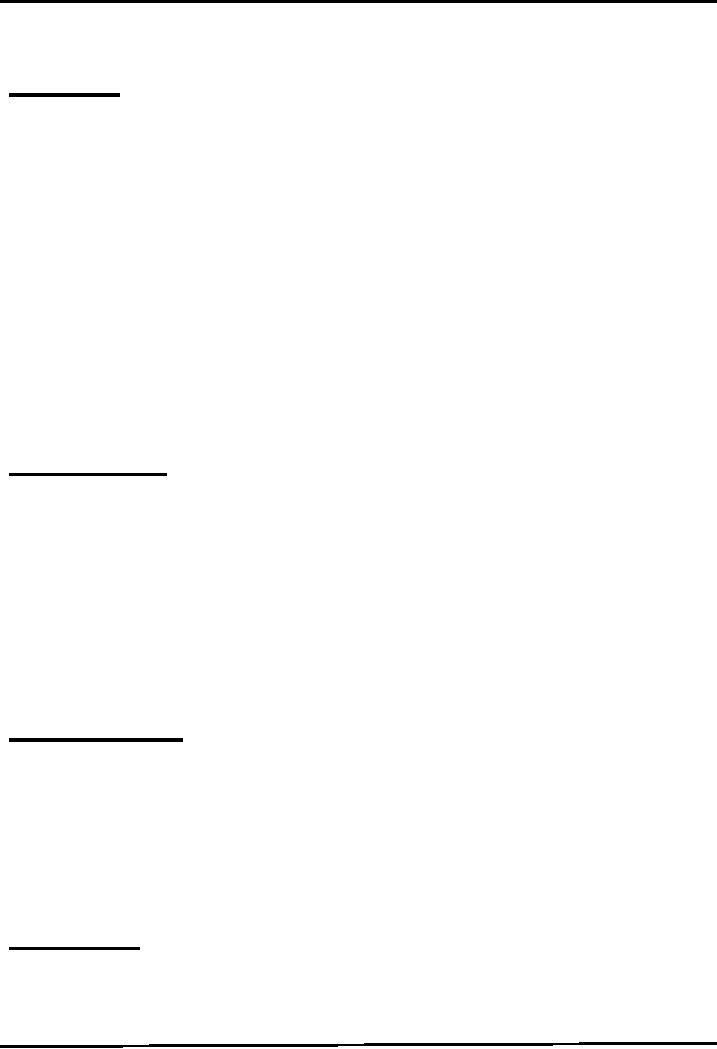
Web
Design & Development CS506
VU
Lesson
7
Intro
to Exceptions
Types
of Errors
Generally,
you can come across three
types of errors while
developing software. These are
Syntax,
Logic
& Runtime errors.
1.
Syntax Errors
Arise
because the rules of the language are
not followed.
2. Logic
Errors
Indicates
that logic used for
coding doesn't produce expected
output.
3.
Runtime Errors
Occur
because the program tries to
perform an operation that is
impossible to complete.
Cause
exceptions and may be handled at runtime
(while you are running the
program)
For
example divide by zero
What is
an Exception?
An
exception is an event that
usually signals an erroneous situation at
run time
Exceptions
are wrapped up as objects
A
program can deal with an
exception in one of three ways:
o
ignore
it
o
handle
it where it occurs
o
handle
it an another place in the program
Why
handle Exceptions?
Helps
to separate error handling
code from main logic
(the normal code you
write) of the program.
As
different sort/type of exceptions can
arise, by handling exceptions we can
distinguish
between them
and write appropriate
handling code for each
type for example we
can
differently
handle exceptions that occur
due to division by Zero and exceptions
that occur due to
non-availability
of a file.
If
not handled properly,
program might
terminate.
Exceptions
in Java
An
exception in java is represented as an
object that's created when
an abnormal situation
arises
in the program. Note that an error is
also represented as an object in
Java, but usually
represents
an unrecoverable situation and should
not be caught
48
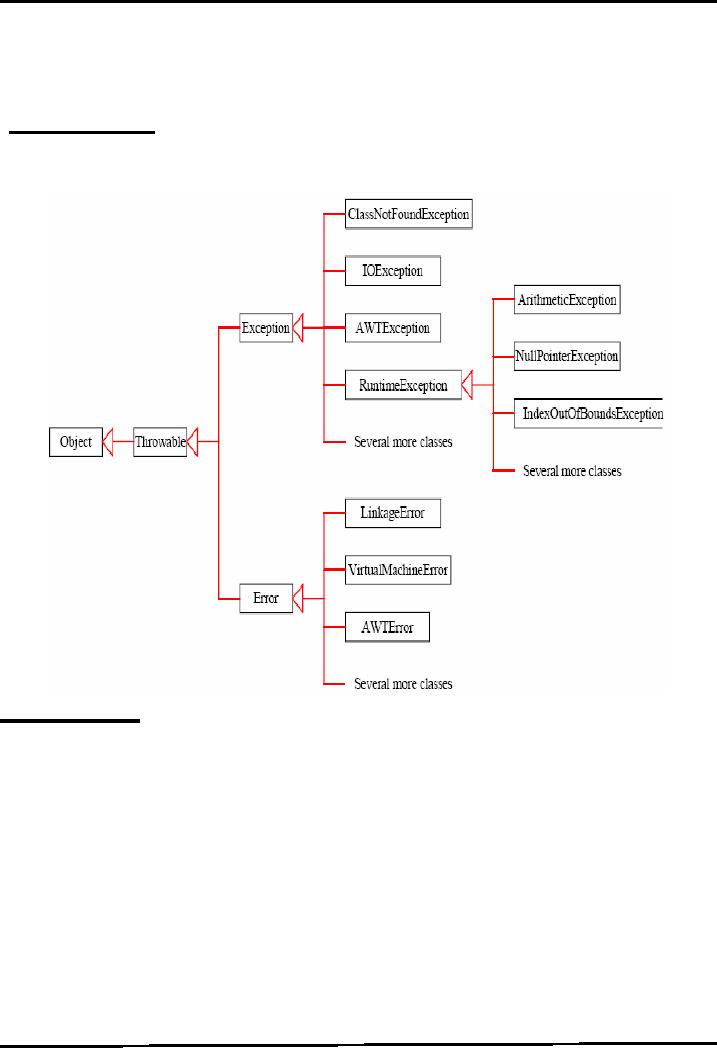
Web
Design & Development CS506
VU
The
exception object stores
information about the nature of the
problem. For example,
due to
network problem or class not
found etc.
All exceptions in
java are inherited from a
class know as Throwable.
Exception
Hierarchy
Following
diagram is an abridged version of
Exception class
hierarchy
Types
of Exceptions
Exceptions
can be broadly categorized into
two types, Unchecked
&
Checked
Exceptions.
Unchecked
Exceptions
�
Subclasses
of RuntimeException and Error.
�
Does
not require explicit
handling
�
Run-time
errors are internal to your program, so
you can get rid of them by
debugging
your
code
�
For
example, null pointer exception;
index out of bounds exception;
division by zero
exception;
...
Checked
Exceptions
�
Must
be caught or declared in a throws
clause
�
Compile
will issue an error if not
handled appropriately
�
Subclasses
of Exception other than
subclasses of RuntimeException.
49
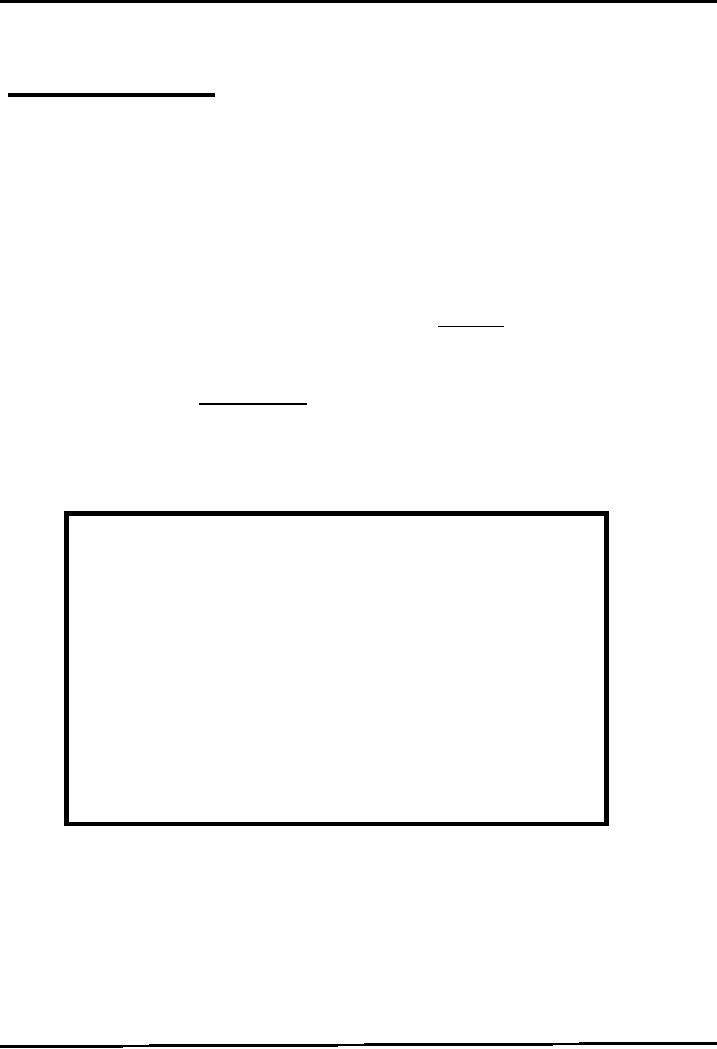
Web
Design & Development CS506
VU
�
Other
arrive from external factors, and cannot
be solved by debugging
�
Communication
from an external resource e.g. a
file server or
database
How
Java handles
Exceptions
Java
handles exceptions via 5 keywords.
try, catch, finally, throw
&
throws.
try
block
�
Write
code inside this block
which could generate
errors
catch
block
�
Code
inside this block is used
for exception
handling
�
When
the exception is raised from
try block, only than
catch block would
execute.
finally
block
�
This
block always executes
whether exception occurs or
not.
�
Write
clean up code here, like
resources (connection with
file or database) that
are
opened may
need to be closed.
The
basic structure of using try
catch finally block is shown in the
picture below:
try
//try
block
{
//
write code that could
generate exceptions
} catch
(<exception
to be caught>)
//catch
block
{
//write
code for exception
handling
catch
(<exception
to be caught>)
//catch
block
{
//code
for exception handling
} finally
//finally
block
{
//any
clean-up code, release the acquired
resources
}
throw
�
To
manually throw an exception,
keyword throw is
used.
Note:
we
are not covering throw
clause in this
handout
throws
�
If method is
not interested in handling the exception
than it can throw back the
exception
to the
caller method using throws
keyword.
50
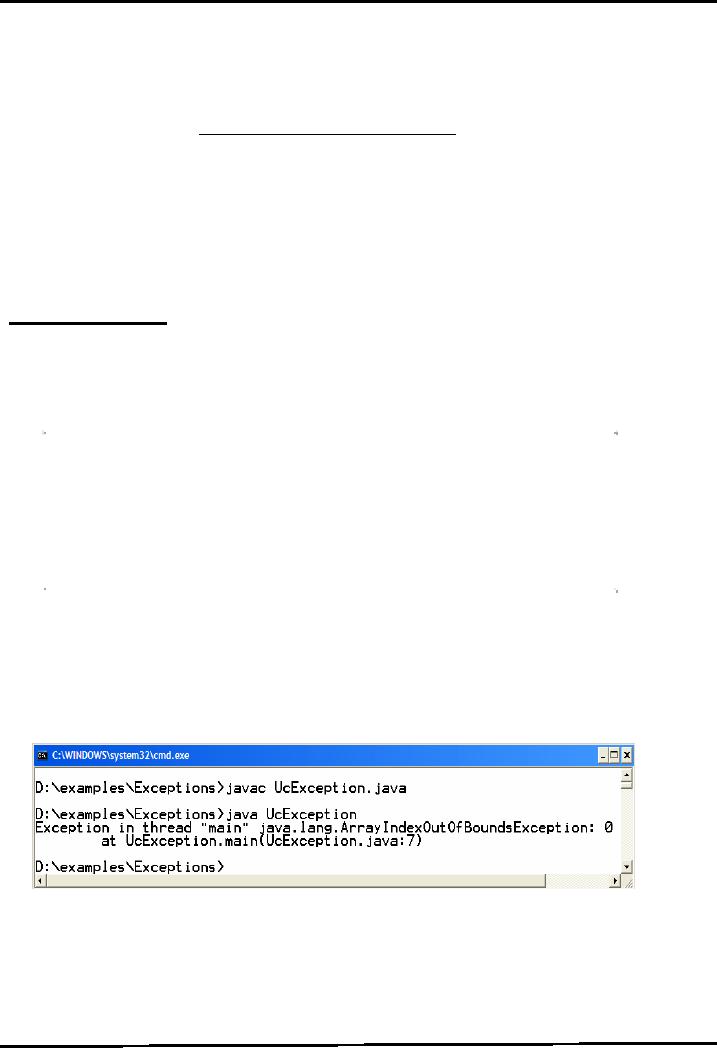
Web
Design & Development CS506
VU
�
Any
exception that is thrown out
of a method must be specified as such by
a
throws
clause.
References:
Java
tutorial by Sun:
http://java.sun.com/docs/books/turorial
Beginning
Java2 by Ivor Hortan
Thinking
in Java by Bruce Eckle
CS193j
Stanford University
Code
Examples of Exception Handling
Unchecked
Exceptions
Example
Code: UcException.java
The
following program takes one
command line argument and prints it on
the console
//
File UcException.java
public
class UcException {
public
static void main (String
args[ ]) {
System.out.println(args[0]);
}
}
Compile
& Execute
If we
compile & execute the above program
without passing any command
line argument, an
ArrayIndexOutOfBoundsException
would be thrown. This is shown in the
following picture
Why?
Since we have
passed no argument, therefore the size of
String args[ ] is zero, and
we have tried to access
the
first element (first element has
index zero) of this
array.
From
the output window, you can
find out, which code
line causes the exception to be raised.
In the
above
example, it is
51
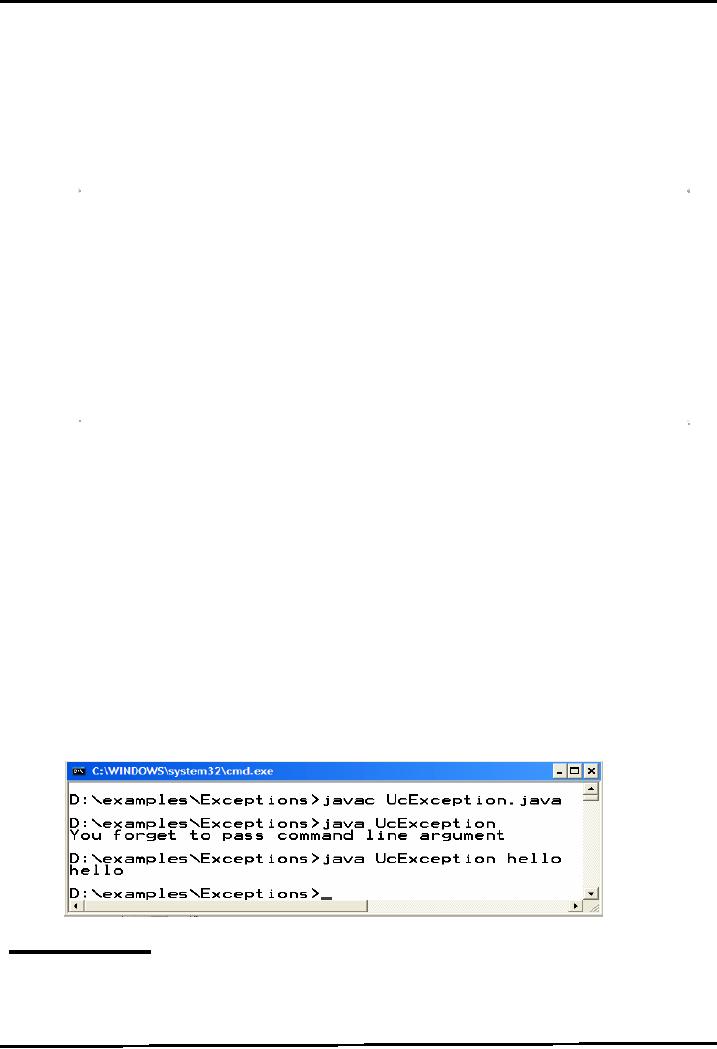
Web
Design & Development CS506
VU
System.out.println(args[0]);
Modify
UcException.java
Though
it is not mandatory to handle unchecked
exceptions we can still
handle
Unchecked
Exceptions if we want to. These
modifications are shown in
bold.
//
File UcException.java
public
class UcException {
public
static void main (String
args[ ]) {
try
{
System.out.println(args[0]);
catch
(IndexOutOfBoundsExceptoin ex)
{
System.out.println("You
forget to pass command line
argument");
}
}
The
possible exception that can be
thrown is IndexOutOfBoundsException, so we
handle it in the
catch
block.
When
an exception occurs, such as
IndexOutOfBoundsException in this case,
then an object of
type
IndexOutOfBoundesException is created and it is
passed to the corresponding catch
block
(i.e. the catch block which
is capable of handling this
exception). The catch block
receives
the
exception object inside a
variable which is ex
in
this case. It can be any
name; it is similar to
the
parameter declared in the method signature. It
receives the object of exception
type
(IndexOutOfBoundsExceptoin)
it is declared.
Compile
& Execute
If we execute the
modified program by passing
command line argument, the program would
display
on console the
provided argument. After that if we
execute this program again
without passing
command
line argument, this time
information message would be
displayed which is written
inside
catch
block.
Checked
Exceptions
Example
Code: CException.java
52
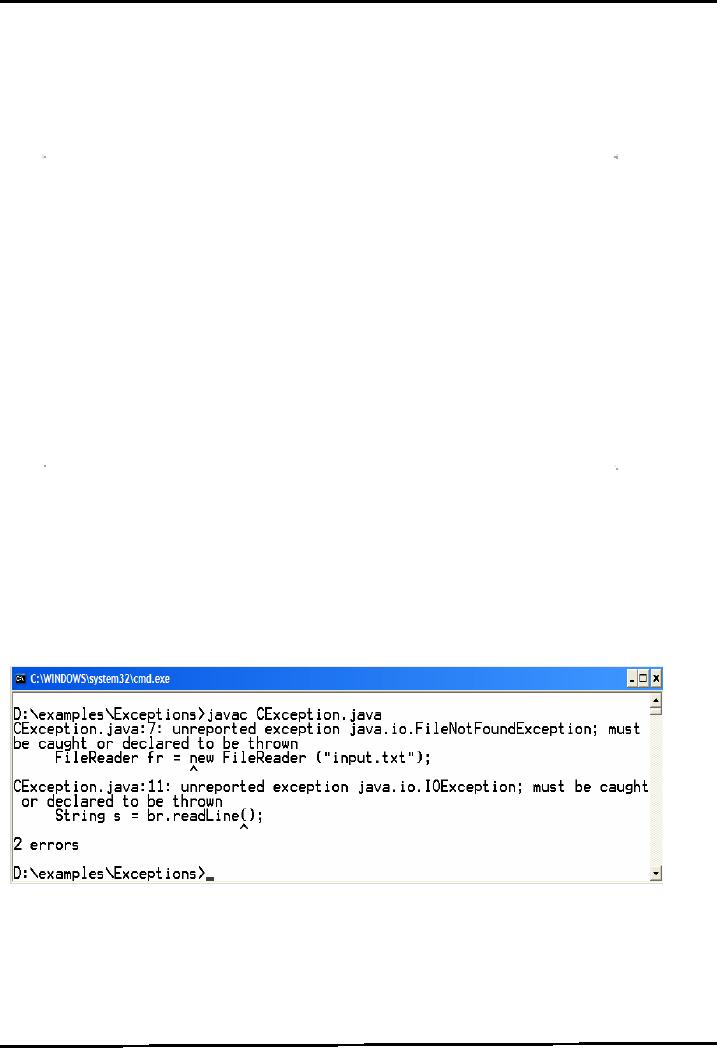
Web
Design & Development CS506
VU
The
following program reads a
line (hello
world) from
a file and prints it on the console.
The File
reading
code is probably new for
you. We'll explain it in the
coming handouts
(Streams).
For now, assumed that the
code written inside the main
read one line from a file
and
prints
that to console.
//
File CException.java
import
java.io.* ;
public
class CException {
public
static void main (String
args[ ]) {
FileReader fr =
new FileReader ("input.txt");
BufferedReader br
= new BufferedReader (fr);
//read the
line form file
String
line = br.readLine();
System.out.println(line);
}
}
Compile
& Execute
If
you try to compile this
program, the program will not
compile successfully and displays
the
message
of unreported exception. This
happens when there is code
that can generate a
checked
exception
but you have not handled
that exception. Remember
checked exceptions are
detected
by
compiler. As we early discussed,
without handling Checked exception,
out program won't
compile.
Modify
CException.java
As we have
discussed earlier, it is mandatory to handle
checked exceptions. In order to compile
the
code
above, we modify the above
program so that file reading
code is placed inside a try
block. The
expected
exception (IOException) that
can be raised is caught in catch
block.
//
File CException.java
53
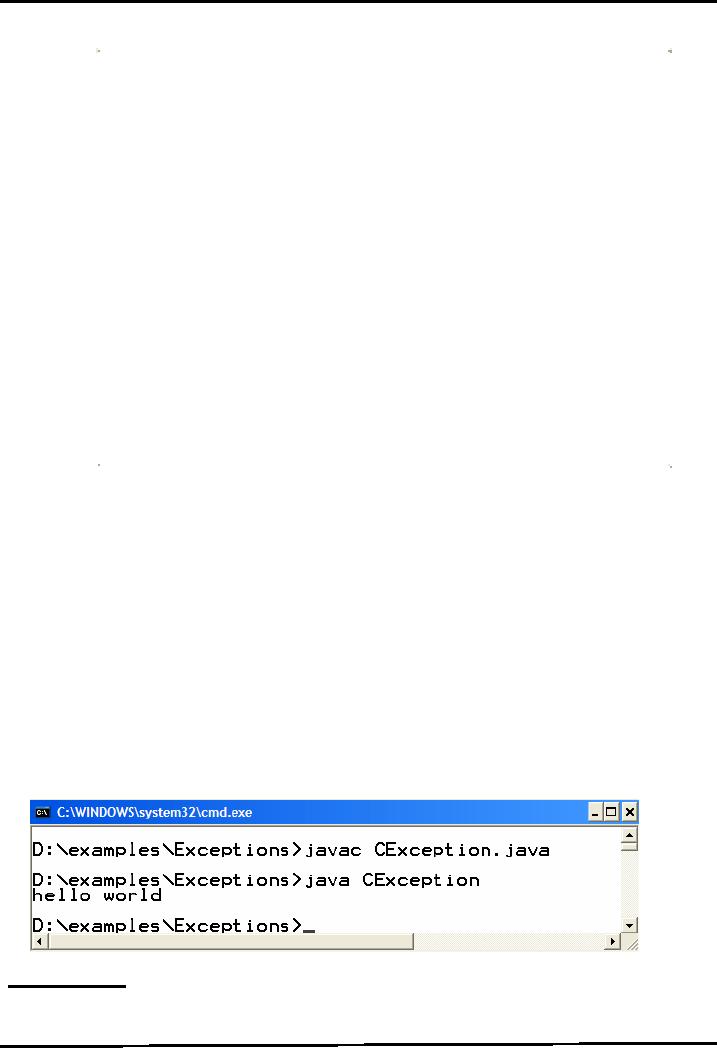
Web
Design & Development CS506
VU
import
java.io.* ;
public
class CException {
public
static void main (String
args[ ]) {
try{
FileReader fr =
new FileReader ("input.txt");
BufferedReader br
= new BufferedReader (fr);
//read the
line form file
String
line = br.readLine();
System.out.println(line);
catch(
IOExceptoin ex) {
System.out.println(ex);
}
}
}
The
code line written inside the
catch block will print the
exception name on the console if
exception
occurs
Compile
& Execute
After
making changes to your program, it
would compile successfully. On
executing this program, hello
world
would
be displayed on the console
Note:
Before
executing, make sure that a
text file named input.txt
must
be placed in the same
directory
where the program is saved. Also
write hello
world in
that file before saving
it.
The
finally block
The
finally block always
executes regardless of exception is
raised or not while as you
remembered
the
catch block only executes
when an exception is raised.
54
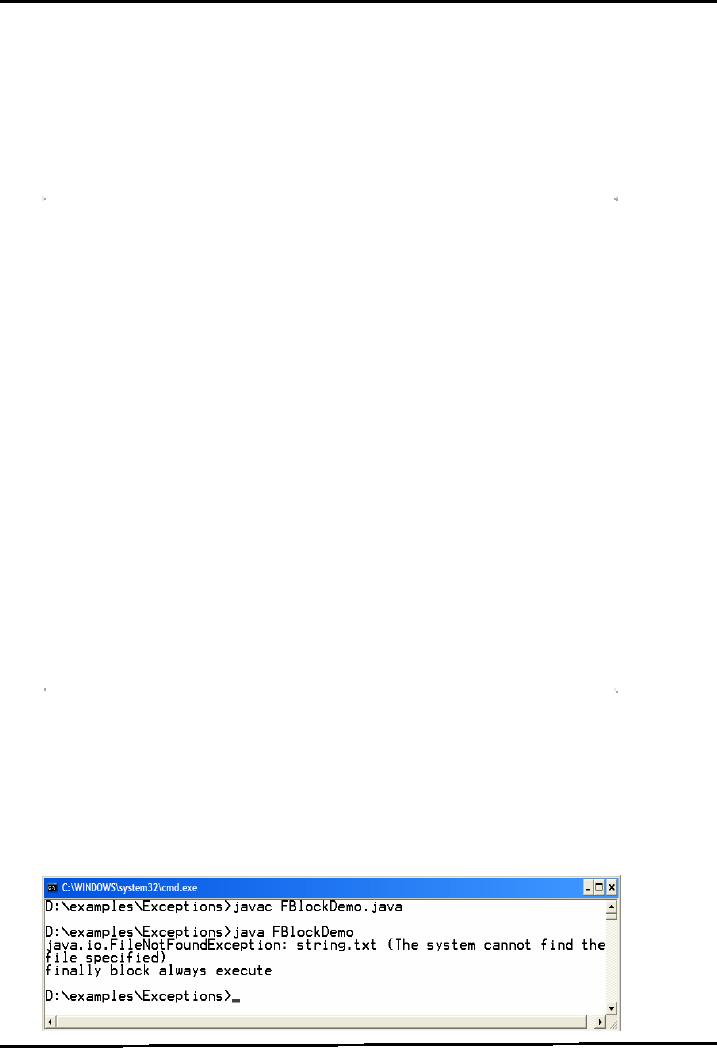
Web
Design & Development CS506
VU
Exampel
Code : FBlockDemo.java
//
File FBlockDemo.java
import
java.io.* ;
public
class FBlockDemo {
public
static void main (String
args[ ]) {
try{
FileReader fr =
new FileReader ("strings.txt");
BufferedReader br
= new BufferedReader (fr);
//read the
line form file
String
line = br.readLine();
System.out.println(line);
catch(
IOExceptoin ex) {
System.out.println(ex);
}
finally
{
System.out.println("finally
block always execute");
}
}
}
Compile
& Execute
The
program above, will read one
line from string.txt
file.
If string.tx
is
not present in the same
directory
the
FileNotFoundException would be raised and
catch block would execute as
well as the finally
block.
55
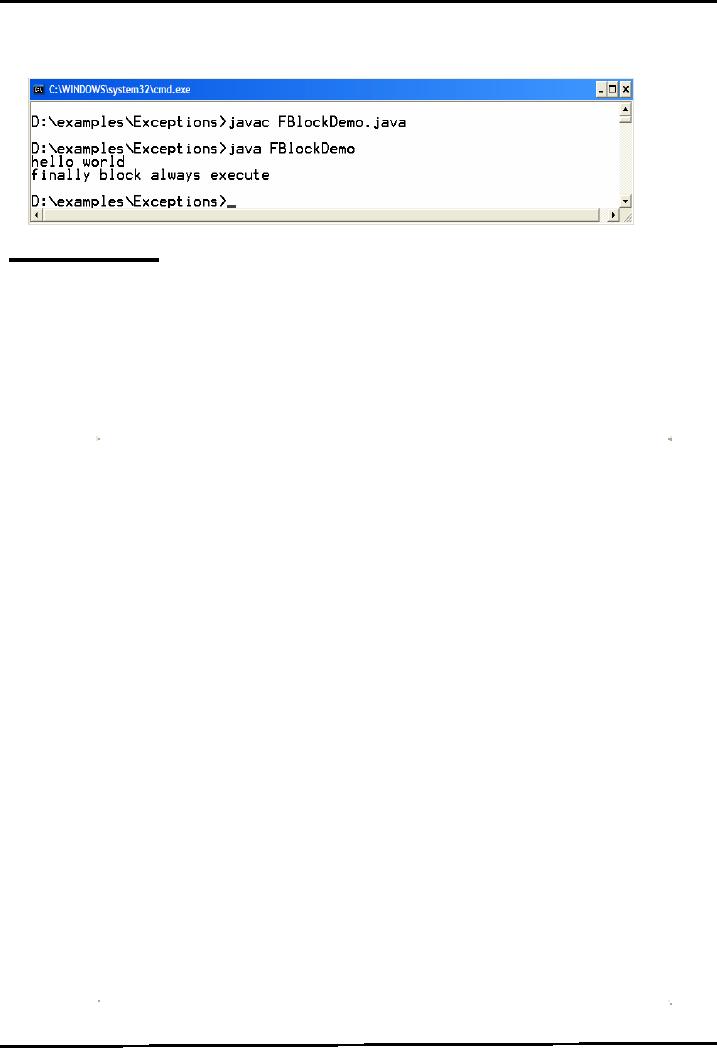
Web
Design & Development CS506
VU
If string.txt
is
present there, no such exception
would be raised but still
finally block executes.
This
is shown in the
following output
diagram
Multiple
catch blocks
�
Possible
to have multiple catch clauses
for a single try
statement
Essentially
checking for different types of
exceptions that may happen
�
Evaluated
in the order of the code
Bear
in mind the Exception hierarchy when
writing multiple catch
clauses!
If
you catch Exception first
and then IOException, the IOException
will never be caught!
Example
code: MCatchDemo.java
The
following program would read
a number form a file numbers.txt
and
than prints its square on
the
console
//
File MCatchDemo.java
import
java.io.* ;
public
class MCatchDemo {
public
static void main (String
args[ ]) {
try{
//
can throw FileNotFound or
IOException
FileReader fr =
new FileReader ("numbers.txt");
BufferedReader br
= new BufferedReader (fr);
//read the number
form file
String
s = br.readLine();
//may
throws NumberFormatException, if s is not a
no.
56
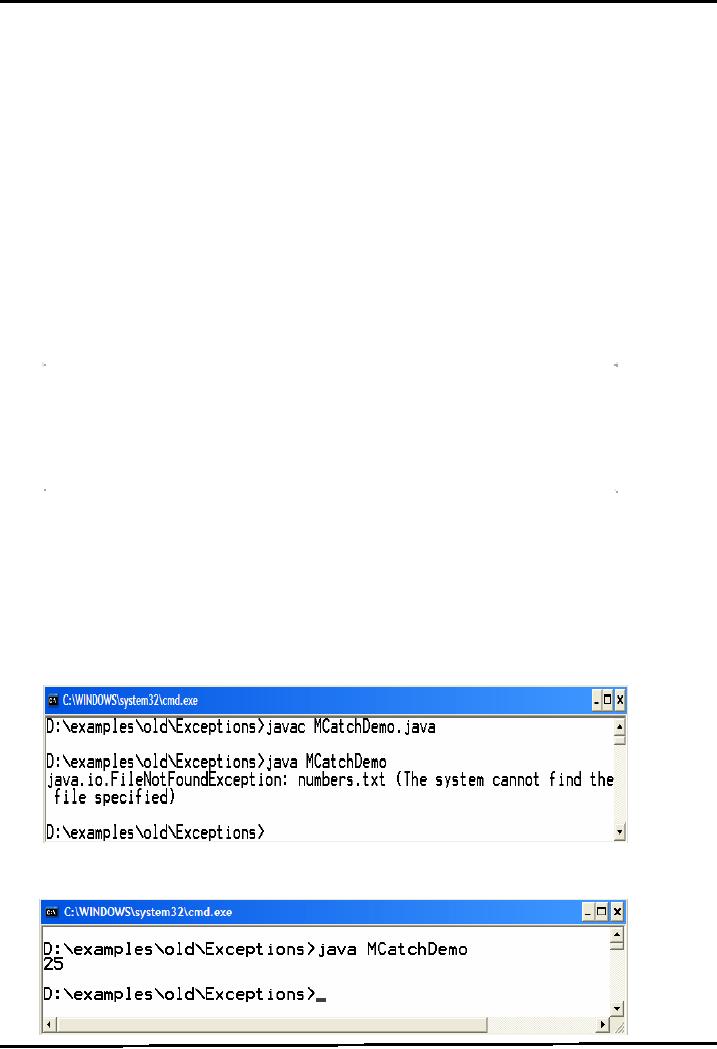
Web
Design & Development CS506
VU
int
number = Integer.parseInt(s);
System.out.println(number
* number);
catch(
NumberFormatExceptoin nfEx) {
System.out.println(nfEx);
}
catch(
FileNotFoundExceptoin fnfEx) {
System.out.println(fnfEx);
}
catch(
IOExceptoin ioEx) {
System.out.println(ioEx);
}
}
}
We
read everything from a file
(numbers, floating values or text) as a
String. That's why we
first
convert
it to number and than print its square on
console.
Compile
& Execute
If
file numbers.txt
is
not present in the same
directory, the
FileNotFoundException
would
be thrown during
execution.
If numbers.txt
present
in the same directory and contains a number,
than hopefully no exception
would
be thrown.
57
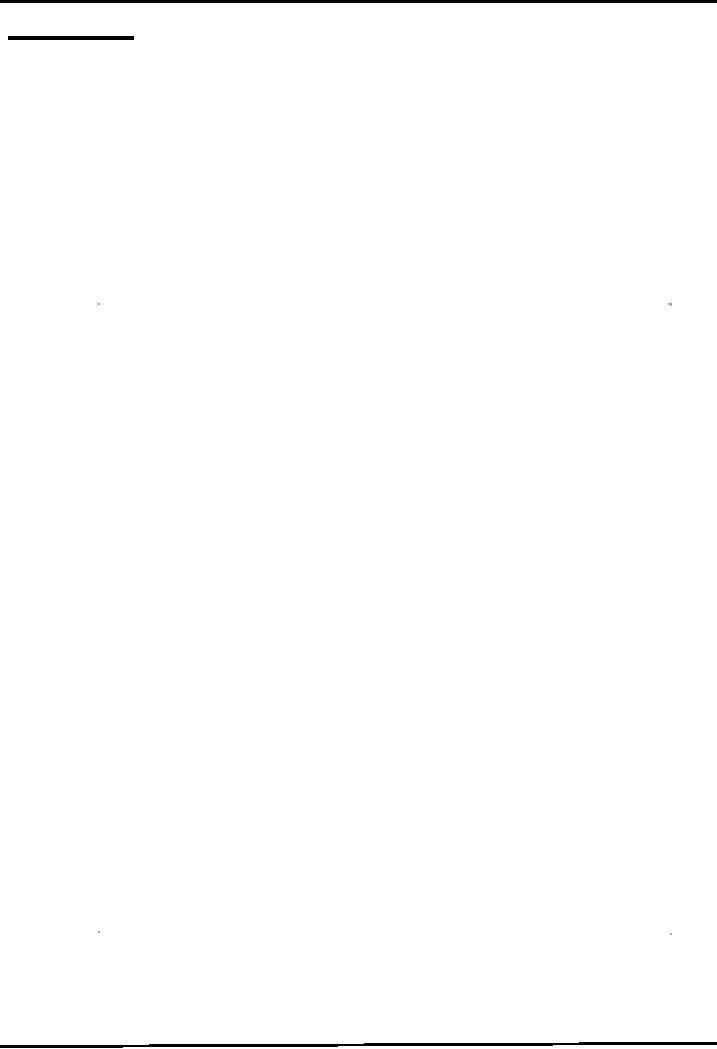
Web
Design & Development CS506
VU
The
throws clause
The
following code examples will
introduce you with writing
& using throws
clause.
Example
Code: ThrowsDemo.java
The
ThrowsDemo.java contains two methods
namely method1 & method2 and one main
method. The
main
method will make call to method1 and
than method1 will call method2.
The method2 contains
the
file reading code. The
program looks like one given
below
//
File ThrowsDemo.java
import
java.io.* ;
public
class ThrowsDemo {
//
contains file reading
code
public
static void method2( )
{
try{
FileReader fr =
new FileReader ("strings.txt");
BufferedReader br
= new BufferedReader (fr);
//read the
line form file
String
s = br.readLine();
System.out.println(s);
catch(
IOExceptoin ioEx) {
ioEx.printStackTrace();
}
}//
end method 2
//only
calling method2
public
static void method1( )
{
method2();
}
public
static void main (String
args[ ]) {
ThrowsDemo.method1();
}
}
printStackTrace
method
Defined
in the Throwable class superclass
of Exception & Error
classes
58
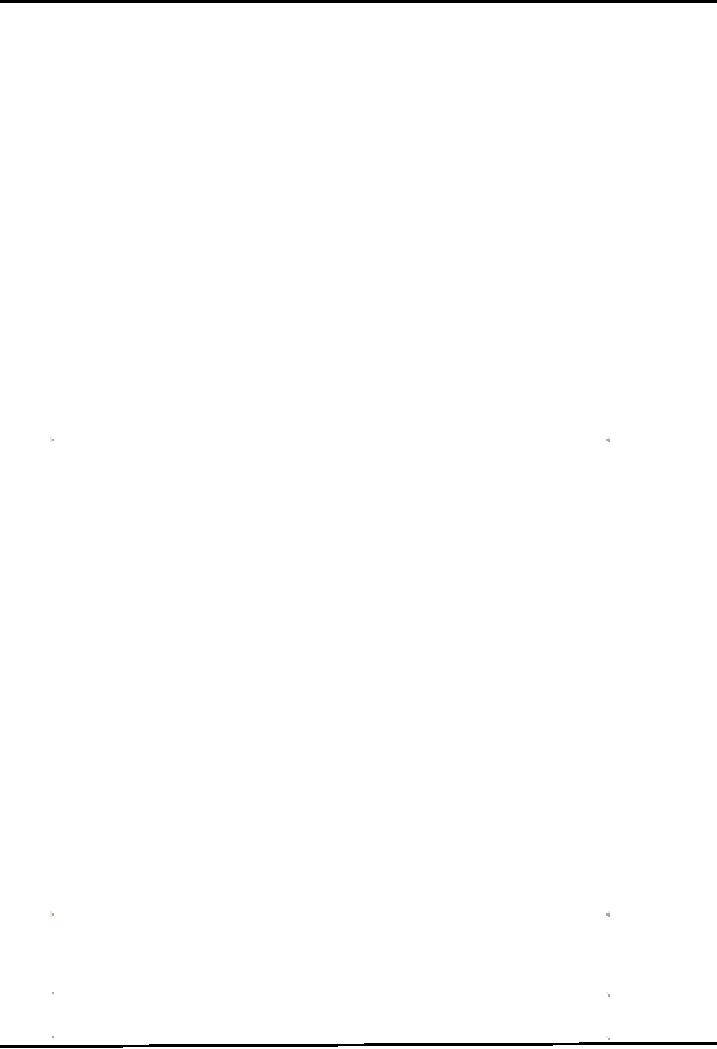
Web
Design & Development CS506
VU
Shows
you the full method calling
history with line
numbers.
Extremely
useful in debugging
Modify:
ThrowsDemo.java
Let
method2 doesn't want to handle
exception by itself, so it throws the
exception to the caller of
method2
i.e. method1
So method1
either have to handle the
incoming exception or it can
re-throw it to its caller
i.e. main.
Let
method1 is handling the exception, so
method1& method2 would be modified
as:
//
File ThrowsDemo.java
import
java.io.* ;
public
class ThrowsDemo {
//
contains file reading
code
public
static void method2( ) throws
IOEception{
FileReader fr =
new FileReader ("strings.txt");
BufferedReader br
= new BufferedReader (fr);
//read the
line form file
String
s = br.readLine();
System.out.println(s);
}//
end method 2
//
calling method2 & handling incoming
exception
public
static void method1( ) {
try
{
method2();
catch
(IOException ioEx) {
ioEx.printStackTrace();
}
}
public
static void main (String
args[ ]) {
ThrowsDemo.method1();
}
}
59
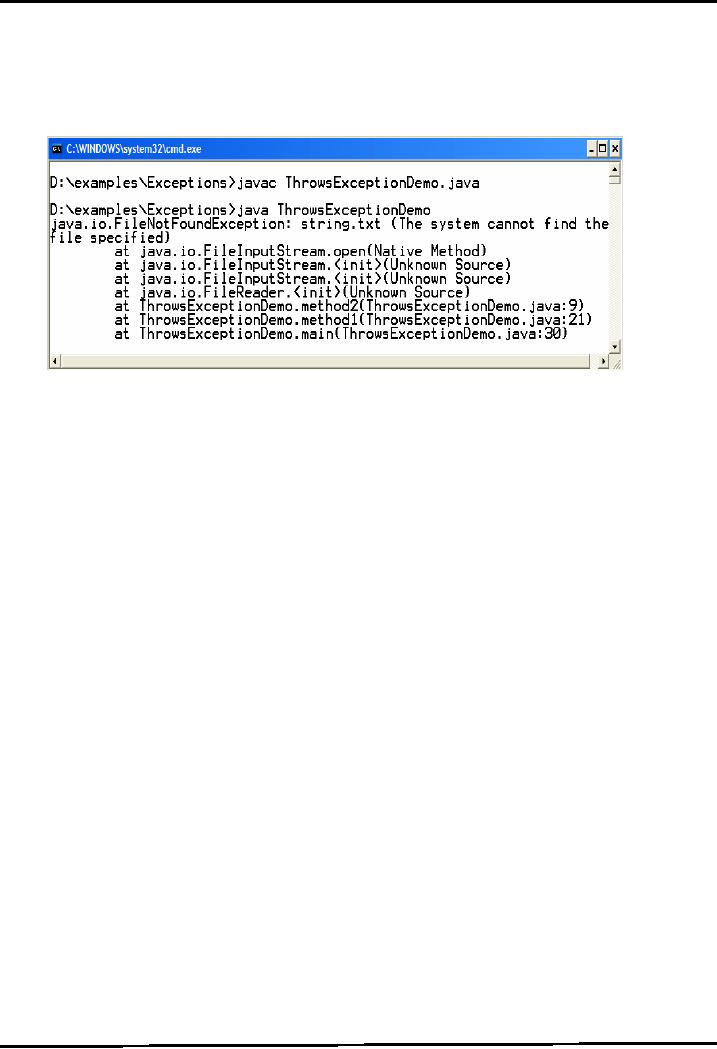
Web
Design & Development CS506
VU
Compile
& Execute
If
file strings.txt
is
not present in the same
directory, method2 will throw an
exception that would
be
caught by method1
and the printStackTrace method will print
the full calling history on console.
The
above
scenario is shown in the output
below:
If
file strings.txt
exist
there, than hopefully line would be
displayed on the console.
Reference
Example
code, their explanations and
corresponding figures for this
handout are taken from the
book
JAVA A
Lab Course by Umair Javed.
This material is available
just for the use of VU
students of the
course
Web Design and Development and
not for any other commercial
purpose without the consent
of
author.
60
Table of Contents:
- JAVA FEATURES
- Java Virtual Machine & Runtime Environment
- Learning Basics of JAVA
- JAVA: Object Oriented Programming
- JAVA: Inheritance
- JAVA: Collections
- JAVA: Intro to Exceptions
- JAVA: Streams
- JAVA: Modification of Address Book Code
- JAVA: Graphical User Interfaces
- JAVA: Event Handling
- JAVA: More Examples of Handling Events
- JAVA: Problem in Last Code Example
- Java Database Connectivity
- JAVA: More on JDBC
- JAVA: Result Set
- JAVA: Meta Data
- Java Graphics
- JAVA: How to Animate
- JAVA Applets
- JAVA: Socket Programming
- JAVA: Serialization
- JAVA: Multithreading 1
- JAVA: Multithreading 2
- JAVA Web Application Development
- Java Servlets
- JAVA: Creating a Simple Web Application in Tomcat
- JAVA: Servlets Lifecycle
- JAVA: More on Servlets
- JAVA: Dispatching Requests
- JAVA: Session Tracking 1
- JAVA: Session Tracking 2
- JAVA: AddressBook Case Study Using Sevlets
- Java Server Pages 1
- JavaServer Pages 2
- Java Server Pages 3
- JAVA: JSP Action Elements and Scope
- JAVA: JSP Custom Tags
- JAVA: MVC + Case Study
- JAVA: MVC Model 2 Architecture
- JAVA: Layers and Tiers
- JAVA: Expression Language
- JAVA: JavaServer Pages Standard Tag Library (JSTL)
- JAVA: Client Side Validation & JavaServer Faces (JSF)
- JAVA: JavaServer Faces